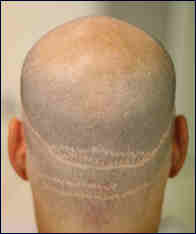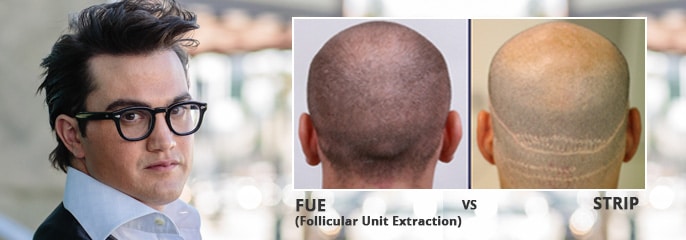FUE VS STRIP
The two transplant methods widely used today are FUE (Follicular Unit Extraction) and STRIP (Follicular Unit Strip Surgery). These procedures differ in the way the donor hair is extracted.
STRIP requires the cutting of a large strip of scalp from the patient's donor area. The incision is then stitched shut, and the grafts are harvested from this strip.
The drawback to this procedure is that the patient is left with a long, linear scar across the donor area. This prevents them from sporting a short hairstyle in the future, as hair must be kept longer to cover the scar. Of greater concern is the possibility of the strip scar not healing properly or stretching, which makes the scar very difficult to conceal.
The revolutionary FUE Hair Transplant procedure addresses these concerns, as individual follicles can be extracted individually from the donor area one by one, eliminating strip removal. This results in significantly reduced healing time, less downtime, and less scarring than the strip procedure. The patient has much more freedom to trim and style their hair shorter in the donor region post-procedure.
1 - FUE - Follicular Unit Extraction

2 - STRIP - Follicular Unit Strip Surgery
- Strip of scalp surgically removed from non-balding area
- Individual grafts placed in incisions in balding area

Advantages of FUE over STRIP

Follicular Unit Strip Surgery (FUT) Disadvantages
- Invasive
- Longer healing recovery time
- Leaves Long Linear strip scars in back of the head
- Potential scar stretching
- More painful procedure with stitches post op
- Longer wait to go back to the gym post op
- CANNOT wear hair short after having the procedure because strip scarring will show








